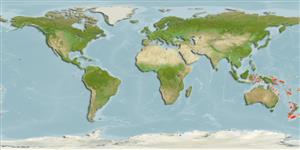Classification / Names
Common names | Synonyms | Catalog of Fishes (gen., sp.) | ITIS | CoL | WoRMS | Cloffa
Actinopterygii (ray-finned fishes) >
Perciformes (Perch-likes) >
Draconettidae (Slope dragonets)
Etymology: Centrodraco: Greek, kentron = sting + Greek, drako = dragon (Ref. 45335); atrifilum: Named for the black filament on the second spine of the first dorsal fin; Latin 'ater' for black and ‘filum’ for thread.. More on author: Fricke.
Environment / Climate / Range
Ecology
Marine; benthopelagic; depth range 437 - 640 m (Ref. 84091). Deep-water, preferred ?
Western Pacific: Australia.
Size / Weight / Age
Maturity: Lm ? range ? - ? cm
Max length : 2.1 cm SL male/unsexed; (Ref. 84091); 3.4 cm SL (female)
Short description
Morphology | Morphometrics
This species is distinguished by having the following characters: anal fin rays 12-13; second dorsal fin rays, 13-14; first dorsal fin with second spine elongate and filamentous in both sexes, the second dorsal fin with no filaments in males; male body colour pattern dorsally with 3 pairs of vertical dark brown streaks, followed by a single saddle below the end of the second dorsal fin and on the caudal peduncle (Ref. 84091).
Specimen was collected with a beam trawl, probably on soft bottom for species of Centrodraco usually occur on patches of soft substrate on the continental slope. Extremely rare in collections, and probably also biologically rare (Ref. 84091).
Life cycle and mating behavior
Maturity | Reproduction | Spawning | Eggs | Fecundity | Larvae
Fricke, R., 2010. Centrodraco atrifilum, a new deepwater dragonet species from eastern Australia (Teleostei: Draconettidae). Stuttgarter Beiträge zur Naturkunde A, Neue Serie 3:341-346. (Ref. 84091)
IUCN Red List Status (Ref. 115185)
CITES (Ref. 94142)
Not Evaluated
Threat to humans
Harmless
Human uses
More information
Common namesSynonymsMetabolismPredatorsEcotoxicologyReproductionMaturitySpawningFecundityEggsEgg development
Age/SizeGrowthLength-weightLength-lengthLength-frequenciesMorphometricsMorphologyLarvaeLarval dynamicsRecruitmentAbundance
ReferencesAquacultureAquaculture profileStrainsGeneticsAllele frequenciesHeritabilityDiseasesProcessingMass conversion
Tools
Special reports
Download XML
Internet sources
